Hechicero Interview 2015
In honor of our friend being on national TV wrestling this week, here’s an interview from Odessa Steps magazine issue five from 2015.
In honor of our friend being on national TV wrestling this week, here’s an interview from Odessa Steps magazine issue five from 2015.
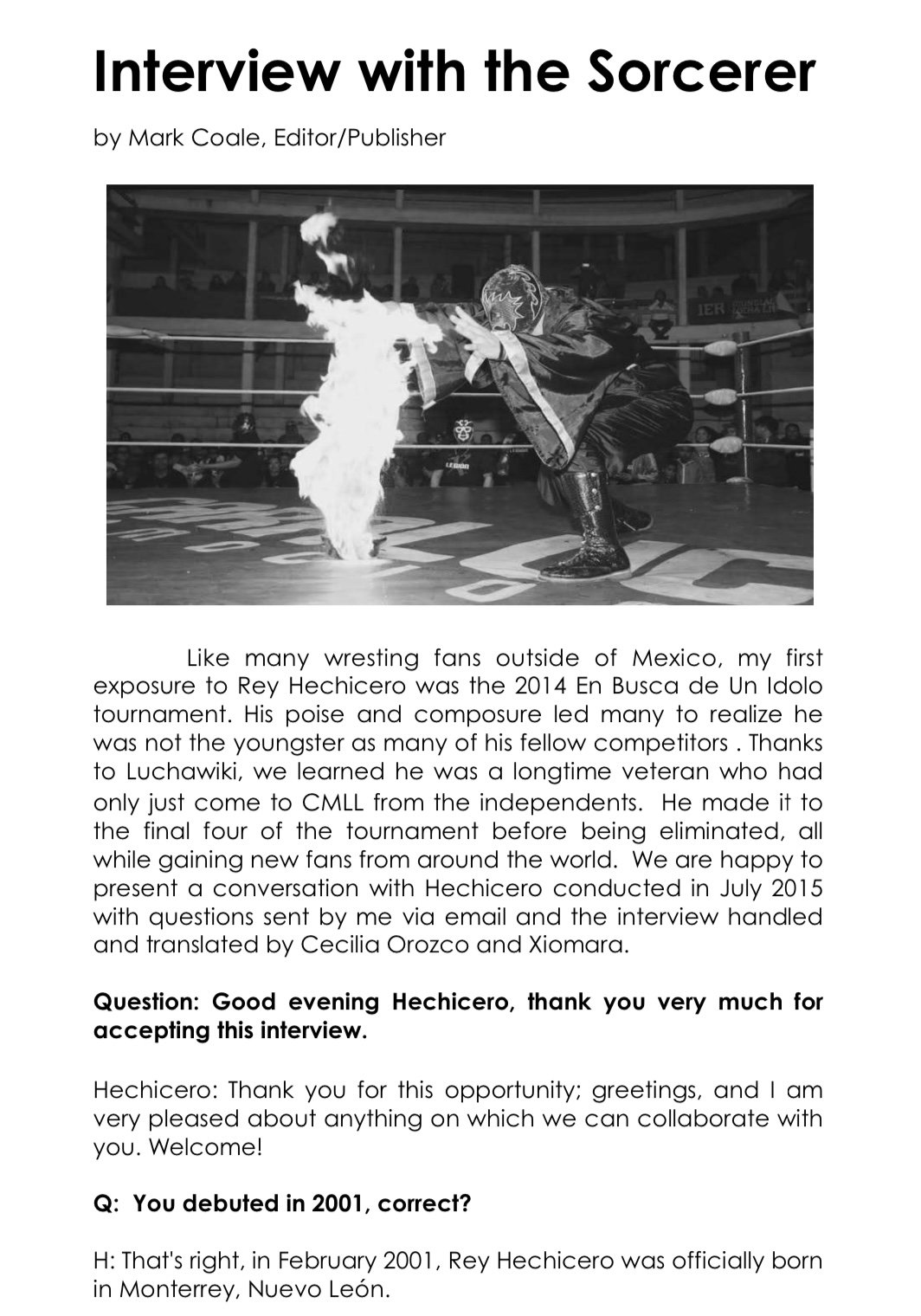
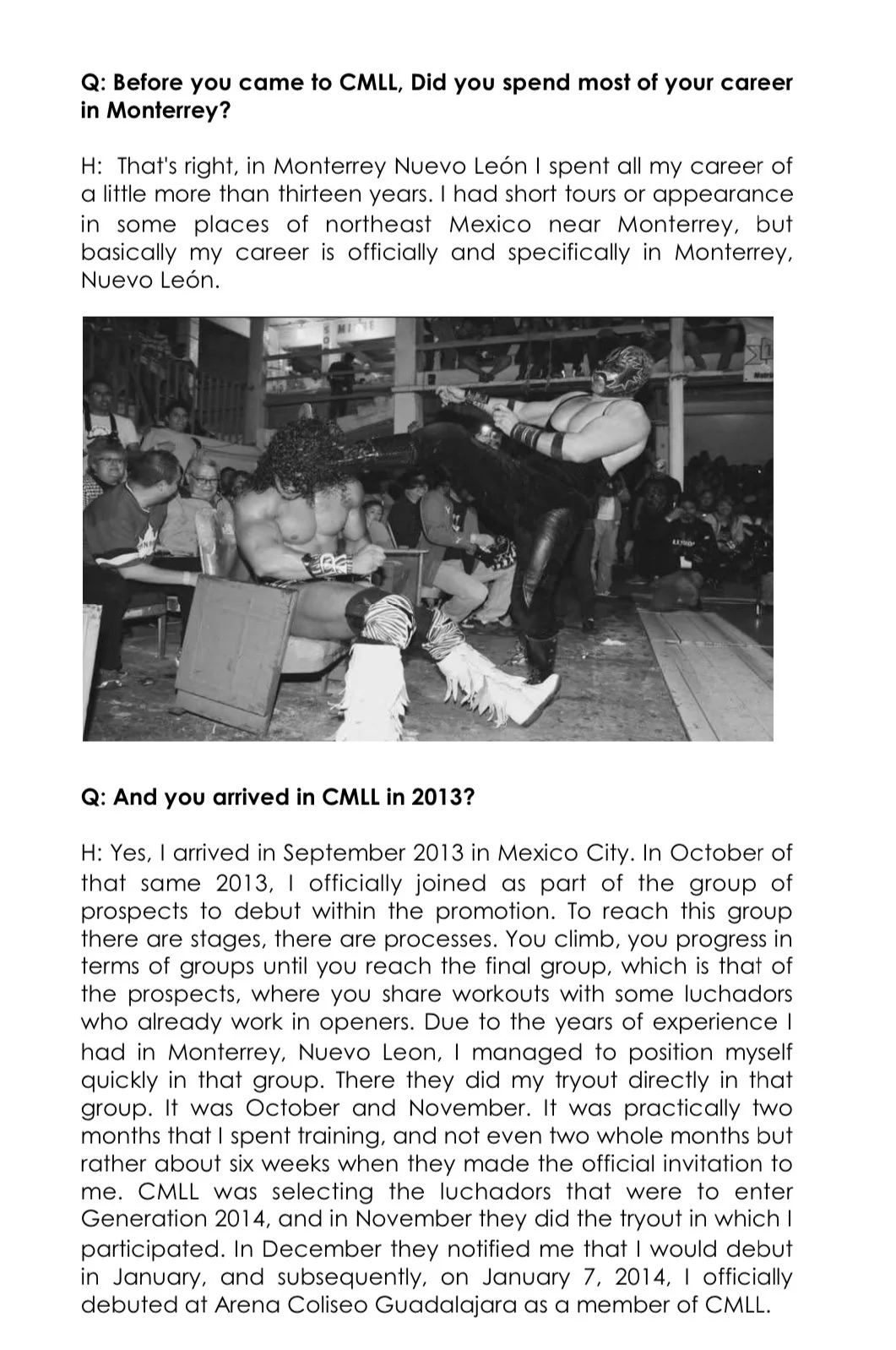


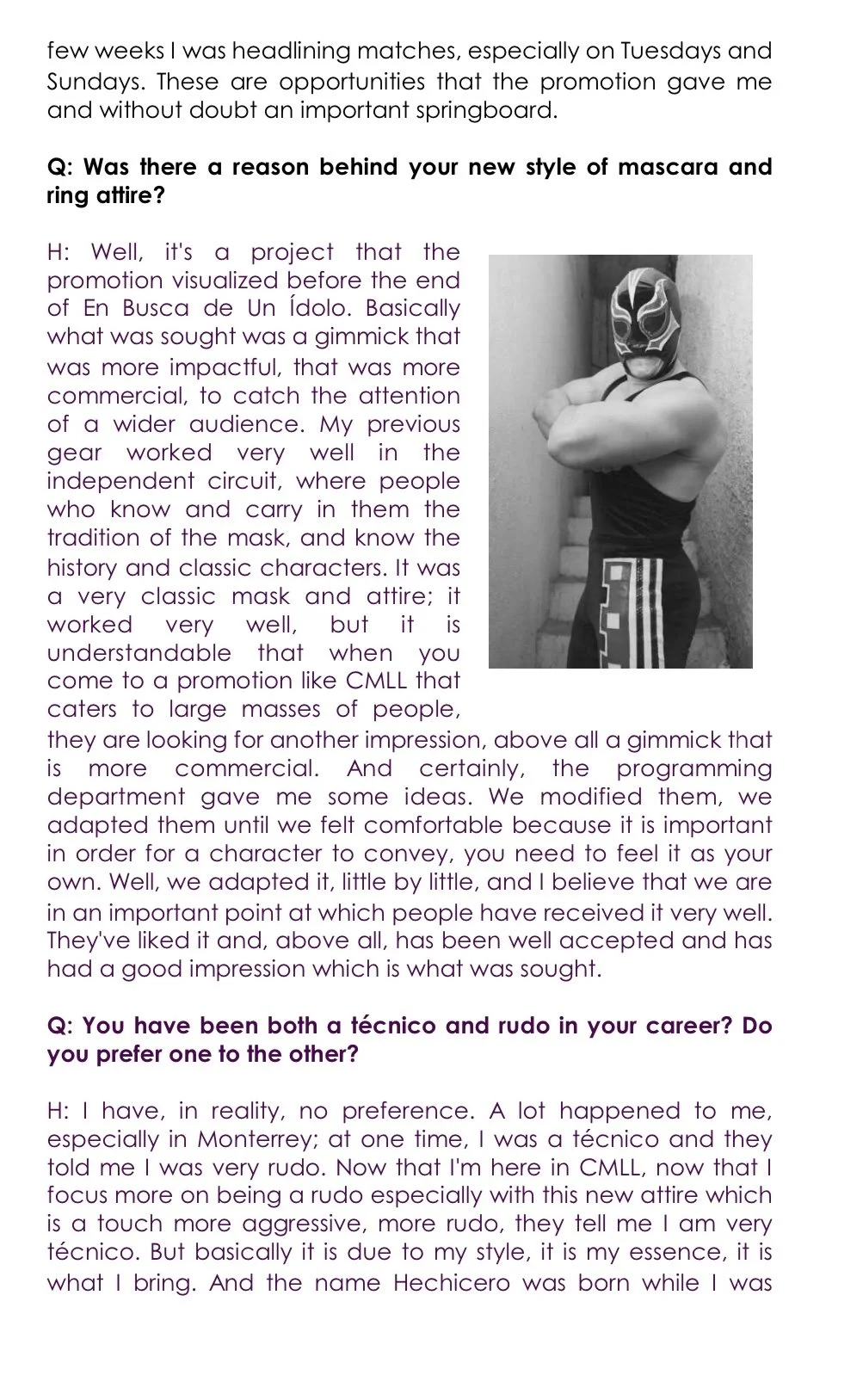
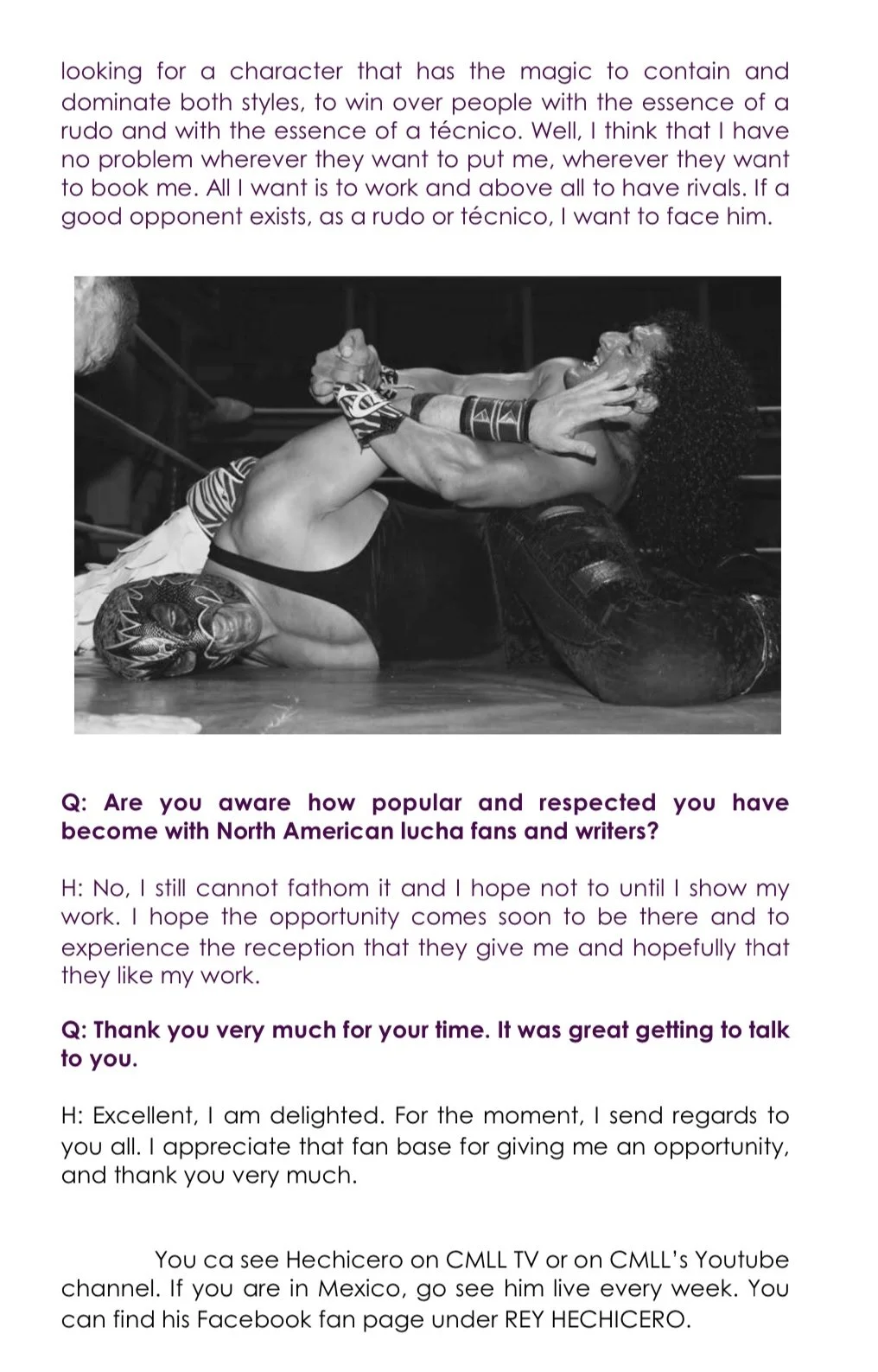
There may be a pod discussing my vote. Might depend on who has time to do something.
HISTORICAL PERFORMERS ERA
Bob Armstrong
June Byers
Archie "Mongolian Stomper" Gouldie
Sputnik Monroe
Dusty Rhodes & Dick Murdoch
Argentina Rocca & Miguel Perez
Ricky Steamboat & Jay Youngblood
MODERN PERFORMERS IN U.S/CANADA
Junkyard Dog
Sgt. Slaughter
Rick & Scott Steiner
JAPAN
Yoshiaki Fujiwara
Manami Toyota & Toshiyo Yamada
Taue and Kawada
MEXICO
Sangre Chicana
Los Hermanos Dinamita (Cien Caras & Mascara Ano 2000 & Universo 2000)
Los Villanos
EUROPE/AUSTRALIA/NEW ZEALAND/PACIFIC ISLANDS/AFRICA
Johnny Saint
Adrian Street
NON-WRESTLERS
Bobby Davis
Bob Caudle
James Melby
Ted Turner
Roy Welch
This article originally appeared in Odessa Steps Magazine, issue 5 in 2015, which was our lucha libre issue that debuted in conjunction with that year’s CMLL Anniversario (since friends of the pod/magazine Randy, Cecilia, Rob and The Cubs Fan were all attending the show that year in Mexico City and they were kind enough to deliver some issues to the luchador(a)s in the issue). As a long-time fan of LOVE & ROCKETS (back to the original magazine days), I’d always love the use of wrestling in the comic. I believe, at least at the time, this was the first “known” article about the use of lucha in the book So, in honor of Jaime’s new book QUEEN OF THE RING, a gorgeous collection of his wrestling art, here is the article, along with the interview I did with Jaime at the time. Be sure to get a copy of the new book in your local comic shop or online.



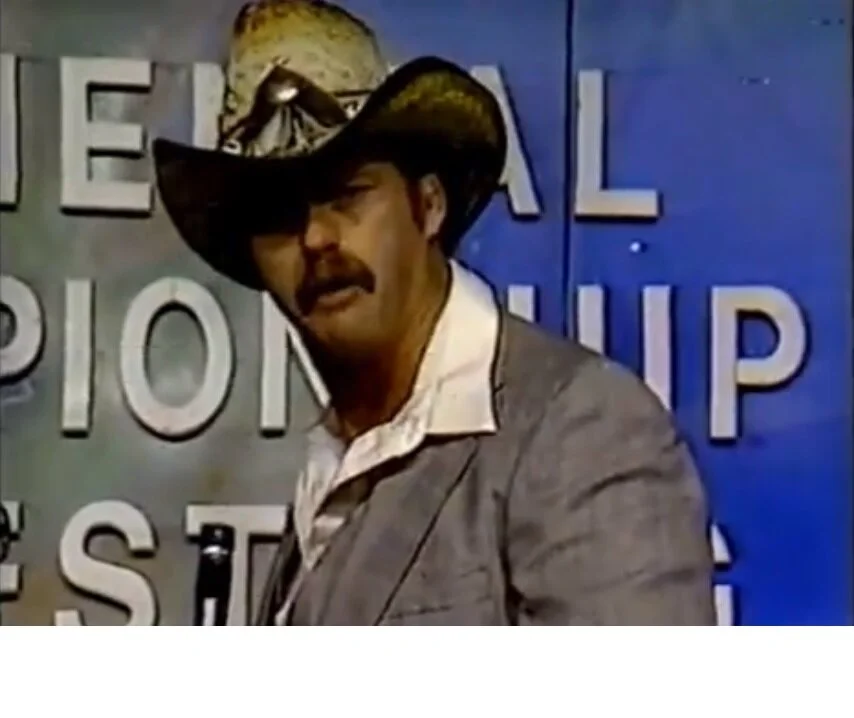
Ron Fuller, man of many hats, adds another: author.
By Ron Fuller Welch
ISBN-10 : 1701818426
Just what can’t Ron Fuller do? The third generation wrestler and promoter, who branched out into minor league hockey ownership when the territory era of wrestling was ending, now turns his hand to writing fiction, a thriller set in his former wrestling home of Knoxville, Tennessee.
The titular main character is not a person, but a lion. And not your warm and cuddly Born Free lion, but a man-eating king of the jungle that has travelled across the continent, hunting two-legged prey. One of his victims, an American trapped named George Steadman, along with his partner Natu, finally manages to capture the great beast and arranges to have him shipped to his employer, the Knoxville Zoo.
And George has the worst of ulterior motives, wanting to get revenge on the animal that took his leg. But what does not plan on is the weird bond that forms between Brutus and George’s nephew Jeb, who works under George in the carnivore department of the zoo.
Needless to say, things do not go as planned once Brutus gets to the zoo. The opening ceremony for the lion’s arrival, planned by the Zoo’s director against George’s advice, goes horribly wrong. And why won’t the great beast eat the slaughtered animals that Jeb provides him?
After a series of events that sees Brutus transferred to the Charlotte Zoo, things go from bad to worse when a landslide in the Great Smoky Mountains frees Brutus from his transport and the killer lion is free to hunt at will in one of America’s biggest national parks. The race is on to capture the lion before the body count gets out of hand.
The novel does a great job in introducing a diverse cast, including a displaced Australian police detective and his family, an ambitious TV reporter, the vain and pompous zoo director and a number of hunters and trappers that come to try and capture Brutus. And Fuller manages to keep ratcheting up the tension, as the deaths continue. A scene late in the book, where the lion has trapped some people in a car, was very reminiscent of the scene in Cujo when the dog menaces some victims also stuck in a car.
Although the book is set in the present, Fuller has said it was originally written years ago and only recently dusted off and published. It certainly feels like a classic Hollywood thriller. I was imagining George C Scott as George Steadman and a young Anthony Perkins as Jeb.
Brutus is a page-turner that was hard to put down, especially once the hunter for The lion begins in the National Park. A great effort from a first-t8me author, albeit one who spent decades writing a different kind of fiction, with a different kind of pencil.
You can order Brutus from Amazon or from Ron directly at tnstud.com, where you can also get an autographed copy.
They Call Me Booker
By Jeff Bowdren
Crowbar Press
By the time I got to college in the late 80s, my interest in wrestling had begun to dissipate. The NWA/Crockett promotion had gotten stale and lost a lot of talent to the WWF. The UWF had gone. The AWA on ESPN was lurching to its end. And, even though I had only starting watching as a teenager a few years ago, I already had grown tired of the WWF version of the business.
My interest eventually picked up again for a couple reasons. Our dorm was one of the few at the time with cable (all of couple dozen channels) and one of those was the Financial News Newtork, which turned into Score on weekends and one of the things they showed was Memphis wrestling. I had only read about the promotion in the Apter mags, since living on the East Coast, we got a lot of shows (including World Class on a UWF station from central PA), but Memphis was not one of them. So, it was cool to finally those guys in person, even if I had seen the territory mainstays in other places like Crockett or the AWA.
The other thing was finding Dave Meltzer’s column in The late, great National daily sports newspaper. And from there, that led me to being a subscriber to the Observer newsletter in November of 1990. (Which means I have been a subscriber for almost 60% of my life.)
And quickly, one of my favorite things in the Observer was the Bowdren the Booker column. Long before the term “fantasy booking” was beaten to death on the Internet (I was still a year away from discovering Usenet while working at the college newspaper), Jeff Bowdren was writing a “What If...” fictional column most weeks in the Observer.
Thankfully, almost three decades later, these are now collected in one book, “They Call Me Booker.” This means never having to dig through boxes and boxes of yellowing paper and trying to squint to read the old Observers written in even harder to read type than what we have now (still the same since 1991. I got on the bandwagon right before Dave upgraded typewriters or word processors.
The column all centers around Jeff being called out of the blue and given the job to book WCW by Ted Turner. Remember, this is 1990, when the great year of 1989 and Flair vs Steamboat and Flair vs Funk had given way to, ... well, let’s not disparage many wrestlers no longer with us that were once big stars.
In hindsight, Bowdren chooses to push many workers who were newsletter favorites back in the day: Barry Windham, Brian Pillman, the great Muta, and the tag team of Owen Hart and Chris Benoit. Reading about the brief real life team in 1990 of Hart and Benoit in 2019 just makes a long time fan mournful.
There is also a special mention here for two guys who have been called underrated for so long, you wonder if they can be called that anymore: Brad Armstrong and Buddy Landell. Both guys are central to the narrative, fulfilling the potential they arguably reached in real life.
And as you would expect from a snarky newsletter wrestling column, there are plenty of in-jokes and references to old angles that would get a pop from most readers who would probably remember most of the bits from the first time around.
I won’t reveal any of the plot twists, as some of the angles and swerves are really clever and do make you wish you could have actually seen this played out at 6:05 on Saturdays or at Starrcade 90 (no black scorpion here).
If you are a longtime or lapsed fan, especially someone who was an Observer reader at the time, this is definitely worth picking up. I mean, it’s better than watching this week’s WWE TV, right?
Rediscovering The Gorgeous One
From Odessa Steps Magazine Issue Six, Matt's article about Gino Hernandez wrestling in Houston for Paul Boesch.
When it comes to pro wrestling, contextual sources should be taken as suspect. House gates can be inflated. Shoot interviews have the most dubious of untrustworthy narrators (wrestlers). Dirt sheets can be contradictory and often received inputs from biased leakers. This is increasingly true the further back you go as such sources become less frequently available, memories become fuzzier, and conventional wisdom overtakes the actual truth. It is even more perilous when judging wrestlers' in-ring skill, for critics may value different attributes than the wrestlers themselves. In such cases, primary sources, filmed matches themselves, in large number and against many different opponents, can serve as the best sort of evidence.
Of course, this also becomes more problematic as we get further into history. Much of what we have on tape, even back into the 80s, tends to be studio matches. Arena footage, those week in and week out matches in front of much the same crowds, where balance between measured innovation, variety, and all the old tricks in the book, was necessary, is exceedingly rare. Thanks to the wonder of Buddy Rose's ego, we have some of the Saturday night Portland TV, which just happened to be from the Arena. Deeper into the decade we have Continental television. Of course, we have the oft-tedious MSG footage and the all-too clipped "garbage tapes" from Mid-Atlantic. Past that, it's just bits and pieces, a Memphis match here, an AWA one there, not whole shows and certainly not whole shows on a weekly basis.
That's always called into question the stories of just how good Gino Hernandez was. Much like a David Von Erich, Gino died young, passing away under debatably suspicious circumstances at age 29. According to Gary Hart's book, this was right before he was to start, with Chris Adams, in Crockett. Up until a year or two, what we had of his career was a bit of Georgia TV, some Southwest TV, World Class TV and some stadium shows, plus a spot or two in Japan. While the World Class footage was very much Gino in his prime, there was only so much one was expected to do against the Von Erichs in Texas. It certainly wasn't comparable to other territorial anchors of the era, be it Rose in Portland or Lawler in Memphis.
That changed with the onset of the NWAonDemand service, footage from the weekly Houston Arena cards from the Paul Boesch library. The footage is generally from 78-86, whole cards posted one match at a time as reels are converted. Gino was a mainstay until 1983 (with a short run in 1984 as well), having turned heel into 1978 and having stayed close to the top of the card as a heatseeker drawing in crowds who wanted to see him get comeuppance until he left. In two years of weekly uploads, we've gotten dozens of Gino matches from multiple eras. In the paragraphs to follow, I'd like to share what we've learned, highlighting some of Gino's feuds and certain takeaways about him as an in-ring worker, using specific matches as primary evidence.
Nothing of babyface Gino has been posted, but we have a number of post-turn matches in 1978 and 1979 that give us a great look at how he was developing as a heel at age 21 and 22. Here he was still finding his way, playing up his flamboyance for the last row and even baiting the crowd's homophobic tendencies a bit. He bumped big and distinctly, including the Flair flip into the corner (which Flair himself could not have been doing for too long), stooged heavily against not just dominant opponents like Rocky Johnson (7/7/78) (going so far as to get spanked by him to the crowd's absolute delight) but also against ones with a sort of moral superiority, like erstwhile ref and occasional wrestler Nick Kozak (9/8/78) or the young Von Erichs.
He was very good, even very early, at only taking advantage in a match after he'd earned it through a bit of underhandness. In taking control against the technically superior Kevin Von Erich (1/11/80), he made sure to pull his opponent's tights to escape a hold and, in the rope-running that followed, made sure to eat a shoulder tackle before sneaking a kneelift in to start the match's heat segment. Even then, he got the most out of what he was doing, tossing Kevin out for a king of the mountain segment; this minimized how much he actually had to get over on Kevin and gave him plenty of time to play to the crowd, both great things for a vulnerable heel. For someone who had to serve as a lead heel in a city, week in and week out, he was incredibly selfless in this regard. While he was portrayed as dangerous and conniving, and while he had a top notch finisher for the late 1970s with his back elbow drop off the second rope, his endless stooging both kept the match engaging and made his opponents look good at all imes, even in defeat. This served to put more all the more heat on him when he won a match, even more than if he had dominated the babyfaces the whole way through.
The footage does come in bits and pieces. For instance, we have only the tiniest hints of his most memorable feud of this earlier era (78-79), with Jose Lothario, his former mentor. Much like Lawler and Dundee in Memphis, they were able to headline cards week after week with a different gimmicks, a karate glove match, a cage match, a Mexican Death match, and a loser painted yellow match. Past some tag team matches with various opponents (including frequent partner Gran Markus for Gino and El Halcon for Lothario) we unfortunately only have the Texas Death Match (1/19/79), but it's viscerally violent and absolutely heated. If Gino was someone whose greatness we can try to reaffirm through the Houston footage, Lothario was a uncovered gem. He was one of wrestling's great punchers with incredible timing on just when to unload on a comeback, knowing exactly how to play the crowd for ultimate effect. The hints of tag matches and promos, along with the big gimmick match, provide sure signs of just how classic this feud was and just why they could successfully run it for as long as they did.
Gino branched out further in 1980, staying near the top of the card in Houston with a number of memorable feuds against a variety of opponents, proving himself by year's end against national and international stars. By this point he could carry even more of his side of the match. He started the year feuding with former partner Gran Markus. In general, he served as a natural foil for someone to turn babyface against, because he was so committed to his character and to drawing heat, even at the expense of his own reputation of toughness. For that reason he made the ideal opponent for newly turned Mark Lewin. We're lucky to have Lewin's face turn against Gary Hart in a match against JJ Dillon's Toru Tanaka (4/11/80). It's a great twenty-five minutes of pro wrestling that had been hidden away from the viewing audience for decades, with the crowd electric for Lewin to break his long-time alliance with his manager. Gino punctuated this perfectly by running into attack Lewin and side with Hart, setting up a feud tht would get the fans to support the turn all the more. The matches that we have (5/16/80, 9/12/80, 10/3/80) show Gino really getting the best out of Lewin, who shined a minamalist walking tall babyface, with big mean shots and a bumping, chickenshit heel to play off of.
Gino played a similar role for Brody at times during the year, and from the footage we've gotten (8/29/80), he served as one of Brody's best opponents in Houston. If you're not going to have someone who will go toe to toe with him and make him give more than usual (like the Mongolian Stomper for whom we have a great Brody match) a heel unafraid to stooge up and down is best. That's not all he could do by this point, however. We have a Jr. Heavyweight Title match with Les Thornton (10/24/80) where he portrayed a more dominant technical cheater, believably keeping the champion on edge throughout the match (we have a great NWA International Jr. Heavyweight title match with Chavo Sr. from the next year (5/22/81) with Lou Thesz as ref where Gino has to literally fight off the crowd on the way in too). There's also a match with the original Sicodelico (5/9/80) where Gino's able to deftly adapt his style to a more lucha feel. Given his last name, he was occasionally paired off with luchadores when they came to Houson. He finished the year with two big matches that really showed his burgeoning star power, first holding his own against Dusty Rhodes (12/5/80), and then working a classic-style NWA Title match with Harley Race (12/11/80). For the NWA title match, the big December show for the year, he worked as an underdog who had the crowd behind him, a heel, but their local, personal one. Still, he never broke his character, ultimately losing his chance due to the over the top rule and then willfully squandering all of the goodwill he had garnered during the match by throwing a temper tantrum.
By the beginning of 1981, Gino was fully developed, able to carry the weight as lead heel against opponents big and small. He'd just survived a gauntlet of Brody, Lewin, Dusty, and Race, but even more telling is his performance from March against someone near the bottom in the card in Gary Young (3/28/81). Young had gone to high school with Gino and he had the crowd's sympathy because he was billed from Houston, but he was an opening match guy. It was definitely a mismatch on paper. Despite that, Gino worked with him for twenty-six minutes, giving up much of the match but always in a way that made Young look good, never really at his own expense. Young lost the match but was far more valuable to Boesch afterwards than he was before. Gino wasn't hurt in the least. That's just how good he had become in a few short years.
At this point, he no longer needed a partner. Despite that, in getting one, he went from being excellent to cementing his legendary status. With the turn of the year to 1981, Boesch moved away from Hart and Lewin and started using Joe Blanchard's Southwest Championship Wrestling talent instead. This brought Tully Blanchard into the territory and it was immediately a match made in hell. The two were the Dynamic Duo, perfectly balanced to one another. Unlike other great teams, be it a flying technician in Bobby Eaton and a flashy showman in Stan Lane or the workrate of Tommy Rogers and the charisma of Bobby Fulton, Gino and Tully were two of the same: dirty, stooging, mean, and arrogant, doubling down on a good thing in a way that's rarely been seen in wrestling history. They were paired off against a myriad of teams and we've been lucky enough to be able to see a number of these matches: against Scott Casey/Tiger Conway Jr. (1/16/81, the first a solid Southwest babyface and the second another hidden find in te Houston footage),Junkyard Dog and Conway (9/25/81), Mil Mascaras and Manny Fernandez (9/18/81), Tommy Rich and Dick Slater (12/11/81), Mascaras and Tito Santana (12/18/81), and into 1982 the lost team of Ricky Morton and Ken Lucas (9/5/82). They were brilliant heels in these matches, showing tail during the shine, cutting off the ring and using every trick in the book when in control, and often times stealing a victory in the most aggravating way possible. Gino stood out especially, a constant burst of motion, always basking in a moment of victory or recoiling against a moment of defeat, gloating from the outside when Tully was in charge, trying to sneak around for a cheapshot at every chance he had. He was fully committed and always on, drawing the fans in from the first instance they saw him to the final one when he retreated to the back. He exuded full investment in about every moment of the match; if he cared that much about what was going on, the fans would too.
The partnership with Tully wasn't just limited to tag matches. Each of them constantly interfered in the other's singles matches as well. There are special matches and moments with Gino we haven't gotten yet (such as the cage match with Rich (5/14/82), set up by Gino costing Rich a title match with Bockwinkel (3/26/82) and with a stipulation that Boesch had to kiss Gino's foot if he won, or a dog collar match with JYD (2/5/82)), but we do have a Mask match vs Mascaras (11/26/82), with Tully in a cage above the ring, and much of the feud with Dick Slater has been released. The latter, much like the Lewin turn, feels like another missing piece of wrestling history finally brought to light. The two feuded over the Southwest title in 1981-1982 and all of this came to head in an incredibly heated loser leaves town challenge in September (9/3/82). The prelude to the match was the duo coming out to attack Tony Atlas after he finished a brass knuckles match with the Mongolian Stomper. Slater made the save and they sgued right into the main event, thus ensuring a certain level of excitement from the very beginning. Atlas and Blanchard would show back up by the end, and the pop and the general atmosphere for Gino finally getting his comeuppance was absolutely electric. It was the sort of sustained pop that would have been talked about for years if we had the footage earlier. This was the sort of reaction that Gino could inspire.
That match and feud, like many of the actual specific details of Gino's pre-World Class career, had simply been forgotten. There was no footage of it. It had not been written about much. Thankfully, though, we were able to see it again after all these years and to get such a better grasp of the true quality of Gino Hernandez as a heel, a star, and a pro wrestler. As I write this, the service's future is up in the air. There are still dozens of Gino Hernandez matches that have not yet been converted and posted. I hope that we get them eventually. For now, though, I''m glad that we've gotten those ones that we have, and that we finally have the proof to realize that Gino was a wrestler who absolutely lived up to both his reputation and his promise. I only wonder what might have been if he had lived into his thirties to go on to Crockett and elsewhere and I think that Paul Boesch, who obviously cared for him so deeply, would be happy to know that a new audience has been able to rediscover him almost forty yearsafter the fact.
In addition to being a contributor to Odessa Steps Magazine and the WInter Palace Podcast, Matt D writes regulary for the Segunda Caida website.

World's Finest issue 15 from 1944. (C) 2016 DC Comics.
We here at the magazine would like to do all we can to keep you from seeing a certain comic book movie that involves traditional super heroes behaving in an nontraditional and unpleasant manner. It's made more money already that it probably deserves, so we'd like to help you save your money by suggesting some alternative viewing choices.
Our five choices were chosen because they are all currently available on one of the main streaming services in the United States (your mileage may vary on foreign soils). We wanted to spread things around and tried to pick a variety of formats, styles and tones.
Batman (1996) - available on Amazon Prime
If you prefer your Batman to be more Caped Crusader than Dark Knight, there's only one place to go: the 1966 Batman movie starring Adam West and Burt Ward. Honestly, we would rather have cherry-picked some of the best TV episodes (starting with the first two episodes versus the Riddler), but those aren't available on any streaming service. We should be happy they are finally out on DVD.
Justice League Unlimited (2004) - available on Netflix
Really, this could be any cartoon from the Dini-Timm universe, but Justice League and Justice League Unlimited give you the most bang for your buck in terms of characters. One of the great strengths of these shows were the ability to use the archetypal versions of the heroes we know well and some we didn't (Shining Knight? Warlord?) It's really hard to go wrong with watching any episode. One of our personal favorites is "The Ties that Bind," by Jim Steranko (@iamsteranko) and (former podcast guest) J.M. DeMatteis (@JMDeMatteis) featuring Mister Miracle, Big Barda and the Flash on Apokolips.
Cowboy Bebop (1998) - available on Hulu Plus
We wanted to put some anime on the list and most of the major streaming services have dozens of shows and movies from which to pick. We're just going to choose Cowboy Bebop, the jazz-infused tale of bounty hunters and their travails. But you can;t go wrong with what are a million other choices.
Barbarella (1968) - available on Netflix
If you don't like your comic books or comic-book adaptations grim and gritty, this camp classic is for you. Based on a French comic of the same name and recently re-translated by popular comics writer Kelly Sue DeConnick (@kellysue), the film, starring a young Jane Fonda, is all about love, or should that be sex. But what was risque in 1968 is pretty tame by 2016 standards; the movie is now rated PG. Watch out for the orgasmotron and evil villain Durand Durand (yes, that's where they got their name).
Jonny Quest Documentary (2009?) - available on YouTube -
This is sort of a cheat, as it is a fan made documentary about the classic Hanna-Barbera cartoon Jonny Quest. But it is as thorough and well-made as any official release you would find on an official DVD release. It has been floating around on the internet for many years, but it's available in various forms on YouTube. I would recommend the three-part version, each about an hour long, part one of which is linked here.
Other documentaries worth checking out online including a conversation between Neil Gaiman and Chip Kidd from the 92Y series (on Amazon Prime) and The Kingdom of Hearts of Dreams and Madness (on Netflix), a profile of Hayao Miyazaki and Studio Ghibli.
The morale here: There are literally hundreds if not thousands of alternatives out there, should you not want to see heroes not act like heroes on a giant Imax screen.